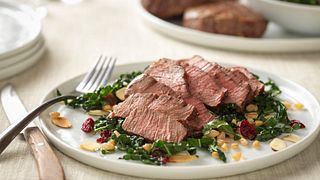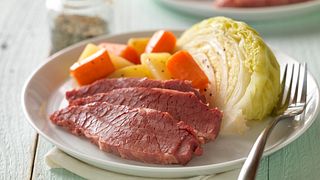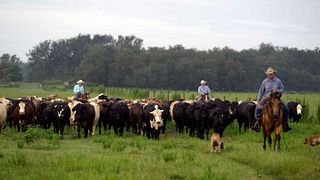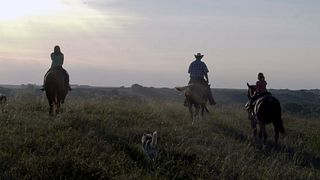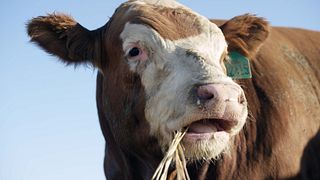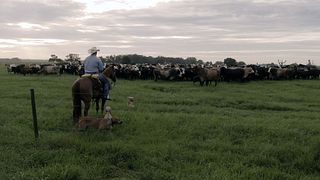Beef is Healthier and More Sustainable than Ever Before
hillary makens| january 16, 2019
Recent reports question beef’s role in a healthy, sustainable diet. Beef is healthier and more sustainable today than at any point in time. History and well-established research have consistently shown that practical, balanced dietary patterns grounded in science promote health and sustainability, not eliminating single foods, like beef.1,2
The U.S. is the leader in sustainable beef production.3
Research recently conducted by the USDA’s Agricultural Research Service and The Beef Checkoff, and published in the journal Agricultural Systems, found that data commonly used to depict beef cattle’s environmental impact in the U.S. is often overestimated. The study, which is the most comprehensive beef lifecycle assessment to-date, evaluated greenhouse gas emissions, feed consumption, water use and fossil fuel inputs. In all these areas, beef’s environmental impacts were found to be less than previously reported.4 Specifically, the report found:
- Beef production, including the production of animal feed, is responsible for only 3.3 percent of greenhouse gas emissions in the U.S.
- Per pound of beef carcass weight, cattle only consume 2.6 pounds of grain, which is similar to pork and poultry.
- Corn used to feed beef cattle only represents approximately 9 percent of harvested corn grain in the U.S., or 8 million acres.
- On average, it takes 308 gallons of water, which is recycled, to produce a pound of boneless beef. In total, water use by beef is only around 5 percent of U.S. water withdrawals.
- Total fossil energy input to U.S. beef cattle production is equivalent to 0.7 percent of total national consumption of fossil fuels.
Not only does this data demonstrate that cattle’s environmental impact is less than often reported, thanks to cattle’s unique digestive system they can actually help mitigate food waste.5
"Cattle are natural upcyclers, which means most of what cattle eat can’t be consumed by humans and would otherwise end up in the landfill,” explained Sara Place, Ph.D., Senior Director of Sustainable Beef Production Research for the National Cattlemen’s Beef Association, a contractor to the Beef Checkoff. “At the end of the day, cattle generate more protein for the human food supply than would exist without them because their unique digestive system allows them to convert human-inedible plants into high-quality protein.”6
It’s also important to note that beef continues to become more sustainable in the U.S. thanks to innovation and production efficiencies. In the U.S. today, the same amount of beef is produced with one-third fewer cattle as compared to the mid-1970s, according to USDA’s National Agricultural Statistics Service. If the rest of the world were as efficient as the U.S., global beef production could double while cutting the global cattle herd by 25 percent.7
Beef supplies essential nutrients and promotes health in a uniquely efficient way.8 ,9
A 3-ounce serving of lean beef provides 10 essential nutrients in about 170 calories, including high-quality protein, zinc, iron and B vitamins. No other protein source offers the same nutrient mix. xiii Furthermore any one of the nearly 40 cuts of beef considered lean can be included as part of a heart-healthy diet to support cardiovascular health, according to recent research from Purdue University. Additionally, research has consistently demonstrated that the nutrients in beef promote health throughout life.11, 12, 13, 14, 15, 16, 17 In particular, the protein, iron, zinc and B-vitamins in beef help ensure young children start life strong, building healthy bodies and brains.11, 12, 13, 14 Protein is also especially important in aging populations due to its ability to help build and maintain muscle. After 50 years of age, adults are at risk for losing muscle mass, leading to falls and frailty that affect their ability to age independently.15, 16, 17
“Research shows that beef can play an important role in promoting health and helping to prevent nutrient deficiencies,” said Shalene McNeill, Ph.D., R.D., Executive Director of Human Nutrition Research at the National Cattlemen’s Beef Association, a contractor to the Beef Checkoff. “Most people already consume beef within established, science-based global dietary guidelines,ix so there is no reason to systematically reduce beef consumption.”
About the Beef Checkoff
The Beef Checkoff Program was established as part of the 1985 Farm Bill. The checkoff assesses $1 per head on the sale of live domestic and imported cattle, in addition to a comparable assessment on imported beef and beef products. States may retain up to 50 cents on the dollar and forward the other 50 cents per head to the Cattlemen's Beef Promotion and Research Board, which administers the national checkoff program, subject to USDA approval.
About NCBA, a Contractor to the Beef Checkoff
The National Cattlemen’s Beef Association (NCBA) is a contractor to the Beef Checkoff Program. The Beef Checkoff Program is administered by the Cattlemen’s Beef Board, with oversight provided by the U.S. Department of Agriculture.
- Dietary Guidelines Advisory Committee. 2015. Scientific Report of the 2015 Dietary Guidelines Advisory Committee: Advisory Report to the Secretary of Health and Human Services and the Secretary of Agriculture. U.S. Department of Agriculture, Agricultural Research Service, Washington, DC. https://health.gov/dietaryguidelines/2015-scientific-report/PDFs/Scientific-Report-of-the-2015-Dietary-Guidelines-Advisory-Committee.pdf
- United States. Department of Health and Human Services., United States. Department of Agriculture., United States. Dietary Guidelines Advisory Committee. Dietary guidelines for Americans, 2015-2020. Eighth edition. ed. Washington, D.C.: U.S. Department of Health and Human Services and U.S. Department of Agriculture; 2015. https://www.cdc.gov/nchs/data/hestat/obesity_adult_07_08/obesity_adult_07_08.pdf
- U.N. Food and Agriculture Organization. FAOSTAT Database – Food and agricultural data. Available at: http://www. fao.org/faostat/en/#home (accessed August 17, 2017).
- CA Rotz, S Asem-Hiablie, S Place, G Thoma., 2018. Environmental footprints of beef cattle production in the United States. Agricultural Systems. Advance online publication. doi.org/10.1016/j.agsy.2018.11.005
- National Academies of Sciences, Engineering, and Medicine. 2016. Nutrient Requirements of Beef Cattle: Eighth Revised Edition. Washington, DC: The National Academies Press. https://doi.org/10.17226/19014
- National Academies of Sciences, Engineering, and Medicine. 2016. Nutrient Requirements of Beef Cattle: Eighth Revised Edition. Washington, DC: The National Academies Press. https://doi.org/10.17226/19014
- U.N. Food and Agriculture Organization. FAOSTAT Database – Food and agricultural data. Available at: http://www. fao.org/faostat/en/#home (accessed August 17, 2017).
- US Department of Agriculture, Agricultural Research Service, Nutrient Data Laboratory. USDA National Nutrient Database for Standard Reference, Legacy. Version Current: April 2018. Internet: /nea/bhnrc/ndl
- Zanovec M, O'Neil CE, Keast DR, Fulgoni VL 3rd, Nicklas TA. Lean beef contributes significant amounts of key nutrients to the diets of US adults: National Health and Nutrition Examination Survey 1999-2004. Nutr Res. 2010 Jun;30(6):375-81.
- O’Connor LE, et al. A Mediterranean-style eating pattern with lean unprocessed red meat has cardiometabolic benefits for adults who are overweight/obese in a randomized crossover controlled feeding trial. Am J Clin Nutr. 2018 Jul 1;108(1):33-40.
- American Academy of Pediatrics. Pediatric Nutrition Handbook. 7th ed. Elk Grove, IL: American Academy of Pediatrics, 2014.
- Tang M, Krebs NF. High protein intake from meat as complementary food increases growth but not adiposity in breastfed infants: a randomized trial. Am J Clin Nutr2014;100:1322-8.
- Nyaradi A, et al. The role of nutrition in children’s neurocognitive development, from pregnancy through childhood. Front Hum Neurosci 2013;7:97.
- Krebs NF, et al. Effects of different complementary feeding regimens on iron status and enteric microbiota in breastfed infants. J Pediatr 2013;163:416-23.
- Wolfe, R. The underappreciated role of muscle in health and disease. Am J Clin Nutr 2006; 84:475-82
- Layman DK, et al. Dietary protein and exercise have additive effects on body composition during weight loss in adult women. J Nutr 2005;135:1903-10.
- Symons TB, et al. Aging does not impair the anabolic response to a protein-rich meal. Am J Clin Nutr 2007;86:451-6.

